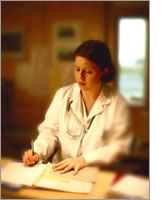Last updated: February 26, 2012
Pilot Program Coordinates Education in Genomic Medicine
Pilot Program Coordinates Education in Genomic Medicine
Healthcare Educators Develop Web Site for Training Materials
 The National Human Genome Research Institute (NHGRI) and the University of Virginia recently initiated a pilot program to help physician assistants and nursing educators jointly develop common training materials on genomic medicine. The materials will be freely available on a Web site that helps both professions achieve competence in the emerging field of genomic medicine. The $100,000 project will help physician assistants and nursing educators develop and review educational information in the arena of genetics and genomics.
The National Human Genome Research Institute (NHGRI) and the University of Virginia recently initiated a pilot program to help physician assistants and nursing educators jointly develop common training materials on genomic medicine. The materials will be freely available on a Web site that helps both professions achieve competence in the emerging field of genomic medicine. The $100,000 project will help physician assistants and nursing educators develop and review educational information in the arena of genetics and genomics.
Because the required educational content for the two groups is very similar, physician assistant and nursing communities have widely adopted structured competencies for genetics and genomics education. The new project relies on these similarities to create a shared, integrated learning and content management system on the Internet that will permit educators from the two professional groups to post competencies, compare overlaps and populate the site with educational materials.
"Most healthcare provider groups have very similar core educational needs in genetics and genomics," said Greg Feero, M.D., Ph.D., who is the Senior Advisor to the NHGRI Director for Genomic Medicine and chief of the institute's Genomic Healthcare Branch. "These needs can be better addressed through this collaborative effort." The educational resources offered on the new site will be mapped to genetic competencies in a way that helps the students improve in specific subjects.
The Web site will also help educators quickly identify materials helpful in teaching a specific competency, as well as resources and tests to measure whether the student has learned the information.
"This resource is more than just a catalog of PowerPoint slides," said principal investigator John Voss, M.D., director of education, Institute for Quality & Patient Safety at the University of Virginia School of Medicine, Charlottesville. The repository will help educators learn from each other as they create and share new teaching material on genetics and genomics. Eventually, the site will allow the user to follow and rate posted materials producing a shared educational resource that is primarily self producing. The site will be free with open access to the public.
Groups supporting the project include the Physician Assistant Education Association, the American Academy of Physician Assistants, the American Association of Colleges of Nursing (AACN), the National League for Nursing, Sigma Theta Tau International, the National Society of Genetic Counselors, as well as the National Coalition for Health Professional Education in Genetics.
"This collaboration helps educators from different professions cross germinate ideas regarding competencies and share teaching and learning tools for genetics," said Connie Goldgar, PA-C, M.S., director of graduate studies, Utah Physician Assistant Program, University of Utah School of Medicine.
While aimed at helping students learn genomic medicine, the Web site is also intended to help educators collaborate in the development of educational content. That collaboration should help ensure that the materials are current and accurate.
"The Web site can serve as a model for the inter-professional training we need to implement in providing best care to our patients," said Dr. Fay Raines, president of AACN. "This resource will be invaluable to nursing school faculty who are working to integrate genetics and genomics content into their curricula, thereby preparing students to provide higher quality patient care."
If the pilot program proves successful, partnerships will be expanded to primary care physician groups and then eventually to all healthcare providers that utilize competency-based approaches to educate their members.
The pilot project is at the end of its planning stages and is scheduled to launch in 2009. For more information about the program, contact Jean Jenkins at jean.jenkins@nih.gov.
Last Reviewed: February 26, 2012
